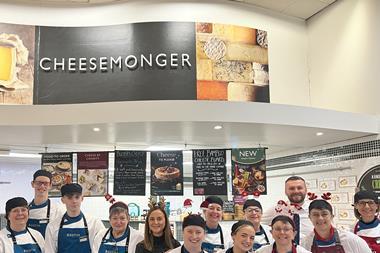What do furniture and cars have to do with efficient consumer response? Good question and one that the most lateral-thinking ECR Europe conference to date gamely attempted to answer in Stockholm last week.
Smoke machines, flashy graphics and a thumping soundtrack featuring Sweden's finest, Abba, greeted the 2,300 delegates filing in for the first plenary speech of the conference, themed 'Northern Light: Inspiring Partnerships through Innovation and Style'.
Dr Hans-Joachim Körber, ECR Europe co-chair and Metro chairman and CEO, kicked off by talking about the need for new thinking, processes and services. That meant looking to other industries, such as furniture and car manufacturing, for inspiration, he said.
Cue a fascinating presentation from Anders Dahlvig, president and CEO of Ikea. If the Ikea brand punched above its weight, that's because it understood and responded to its customers, said Dahlvig. The key was to be different, not better, he argued. "When Ikea was established in the 1960s, the furniture business was very conservative. Ikea turned everything upside down. Furniture had been catering for older people. Ikea came in and did it for younger families."
It introduced many concepts that have only recently become commonplace in retail, notably low pricing, flat packs and global sourcing. Like grocery, low prices were key, he said: "We are almost obsessed with low prices. We are at least 20% cheaper than competitors on similar products."
However, the price message was never allowed to undermine brand or corporate social responsibility values, he insisted. "Many companies try to form a vision of social ambition. The challenge is to make sure it's relevant. We are credible because we believe in what we say. We're also emotionally relevant because of our simple, down to earth approach and cost consciousness, as well as the closeness between managers and workers."
While Ikea was different, it was also consistent, he said. Kenneth Bengtsson, president and CEO of Swedish grocery chain The ICA Group, took a similar line. ICA has 2,300 stores in the Scandinavian and Baltic regions. In order to operate more efficiently, they are run as subsidiaries, initially 91% owned by ICA and 9% by the retailer, and after four to five years, 1% by ICA and 99% by the retailers. Bengtsson said that the model allowed ICA to cater to very different local markets, while still taking advantage of the economies of scale. "It's about central co-ordination and local independence," he said.
Like Dahlvig, he felt that price was important, but not the be all and end all: "Low prices are a prerequisite for staying in the market. But to focus on price alone would be a short-term solution."
Differentiation was vital, he agreed, pointing to ICA's move into healthy ready meals.
Differentiation through innovation was also the theme in the second plenary. Chris Stephens, director of sales strategy projects at Kraft Foods, set the scene by calling on the food and drink industry to take a leading role in innovation. "Be selective - it's clear that, as an industry, we haven't been selective enough. We need to do less but do it better and involve our trade partners. Innovation is a mindset."
It was in a bid to break this mindset that Volvo decided to develop Your Concept Car specifically for women, said Tatiana Butovitsch Temm, corporate communications director at Volvo Cars. "It's the first car where all the decisions have been made by women. Why did we take this angle? In the US, 53% of all Volvo customers are women. In the premium segment in Europe, it averages at 14%, but that figure is growing here and in the rest of the world.
"Our thesis was that if you meet the expectations of women, you exceed the expectations of men," she said, unveiling the results: a sports coupe with gull-wing doors, variable chassis and seating that adapts to the driver.
The YCC resolves the problem of where to put your handbag - between the front seats (the gears are on the steering wheel) and the bonnet cannot be lifted. "What can you do in there?" asked Butovitsch Temm, prompting sniggers from men in the audience.
The car tapped into another major theme at the conference: premiumisation. Jean-Jacques Vandenheede, senior retail analyst at ACNielsen Europe, talked about Harrods 102 and Dream Dinners, a US web-based franchise, which allows people to select a menu and location where, with help, they cook meals to take home and freeze. The car project also required collaboration - a theme that was core to the presentation on Perfect Store by Suzy Ford, category strategy manager at Unilever UK. She updated delegates on the results of a three-year collaboration with United Co-operatives, which resulted in a new look Bradwell store.
Unfortunately, collaboration was all too often an ideal rather than a reality, admitted members of the chief executive panel that followed. Own label was a moot point. Anders Moberg, president and CEO of Ahold, said he had no problem with retailers moving into own label. "We will let consumers choose what is best for them."
But Kees van der Graaf, president of Unilever in Europe, was less sanguine: "We have not seen the benefits of it. On the contrary, we've been confronted with power games. I'm a believer in sticking to your game, and our game is branded goods. I have no problem with retailers doing private label, but it's got to be fair and balanced."
Moberg added that there was still a long way to go on efficient data exchange between suppliers and retailers. Another area that needed to be tackled more collaboratively was corporate social responsibility, said Senator Feargal Quinn, president of Superquinn. And so back to premiumisation for the final plenary. Joanne Denney-Finch, IGD's chief executive and Edwin Booth, chairman of EH Booth & Co, took to the stage together. Denney-Finch said that the rise of premium players such as Whole Foods Market "represents both a threat and an opportunity to the mainstream industry".
She urged people not to make the mistake of dismissing premium as a niche market, as happened with the discounters. After describing the close relationship Booths has with its suppliers, Booth said: "Unfortunately our large supply base has been denuded of profitability by large monolithic retailers that seem intent on promoting lower and lower prices. I hope we've been able to illustrate how small supermarkets can compete."
Meanwhile, the mainstream needed to watch out, warned Denney-Finch: premium players could cream off the top of the market: "In this scenario, low-cost contract manufacturers supply the discount retailers, and small and specialist companies supply the premium sector, leaving just the middle third for the big branded companies of today."
So what do furniture and cars have to do with ECR? Ikea and the YCC team were clearly alive to the threats and opportunities of premiumisation as well as the need for innovation and style.
So quite a lot, as it happens.nhot debates
Some of the most stimulating debates of the conference took place in the break-out sessions. In the session on shelf-ready packaging, Jacques Vincent, vice chairman and chief operating officer, Danone, argued that it should deliver tangible benefits to consumers and that the goal was to make the cake bigger, not more expensive. One supplier criticised the plethora of SRP solutions being developed.
Another pointed out that it wasn't always appropriate for certain products. Procter & Gamble's Graeme Carter called for SRP to be standardised. Tellingly, the retailers present preferred to talk of harmonisation. As for costs, Carter added: "Where it makes sense is where there's no on cost to the manufacturer."
Whether collaborative supply chain efforts were actually working was another hot topic. Accenture's Mark Austin unveiled new research showing that things were not going as smoothly as predicted three years ago. "We forecast much better progress than we've been able to achieve," he said, revealing that 52% of those surveyed had said they were collaborating, but only a third of those had taken it beyond pilot projects. "Collaboration seems to be much more prevalent between manufacturers and their suppliers than manufacturers and customers," he said pointedly.
Smoke machines, flashy graphics and a thumping soundtrack featuring Sweden's finest, Abba, greeted the 2,300 delegates filing in for the first plenary speech of the conference, themed 'Northern Light: Inspiring Partnerships through Innovation and Style'.
Dr Hans-Joachim Körber, ECR Europe co-chair and Metro chairman and CEO, kicked off by talking about the need for new thinking, processes and services. That meant looking to other industries, such as furniture and car manufacturing, for inspiration, he said.
Cue a fascinating presentation from Anders Dahlvig, president and CEO of Ikea. If the Ikea brand punched above its weight, that's because it understood and responded to its customers, said Dahlvig. The key was to be different, not better, he argued. "When Ikea was established in the 1960s, the furniture business was very conservative. Ikea turned everything upside down. Furniture had been catering for older people. Ikea came in and did it for younger families."
It introduced many concepts that have only recently become commonplace in retail, notably low pricing, flat packs and global sourcing. Like grocery, low prices were key, he said: "We are almost obsessed with low prices. We are at least 20% cheaper than competitors on similar products."
However, the price message was never allowed to undermine brand or corporate social responsibility values, he insisted. "Many companies try to form a vision of social ambition. The challenge is to make sure it's relevant. We are credible because we believe in what we say. We're also emotionally relevant because of our simple, down to earth approach and cost consciousness, as well as the closeness between managers and workers."
While Ikea was different, it was also consistent, he said. Kenneth Bengtsson, president and CEO of Swedish grocery chain The ICA Group, took a similar line. ICA has 2,300 stores in the Scandinavian and Baltic regions. In order to operate more efficiently, they are run as subsidiaries, initially 91% owned by ICA and 9% by the retailer, and after four to five years, 1% by ICA and 99% by the retailers. Bengtsson said that the model allowed ICA to cater to very different local markets, while still taking advantage of the economies of scale. "It's about central co-ordination and local independence," he said.
Like Dahlvig, he felt that price was important, but not the be all and end all: "Low prices are a prerequisite for staying in the market. But to focus on price alone would be a short-term solution."
Differentiation was vital, he agreed, pointing to ICA's move into healthy ready meals.
Differentiation through innovation was also the theme in the second plenary. Chris Stephens, director of sales strategy projects at Kraft Foods, set the scene by calling on the food and drink industry to take a leading role in innovation. "Be selective - it's clear that, as an industry, we haven't been selective enough. We need to do less but do it better and involve our trade partners. Innovation is a mindset."
It was in a bid to break this mindset that Volvo decided to develop Your Concept Car specifically for women, said Tatiana Butovitsch Temm, corporate communications director at Volvo Cars. "It's the first car where all the decisions have been made by women. Why did we take this angle? In the US, 53% of all Volvo customers are women. In the premium segment in Europe, it averages at 14%, but that figure is growing here and in the rest of the world.
"Our thesis was that if you meet the expectations of women, you exceed the expectations of men," she said, unveiling the results: a sports coupe with gull-wing doors, variable chassis and seating that adapts to the driver.
The YCC resolves the problem of where to put your handbag - between the front seats (the gears are on the steering wheel) and the bonnet cannot be lifted. "What can you do in there?" asked Butovitsch Temm, prompting sniggers from men in the audience.
The car tapped into another major theme at the conference: premiumisation. Jean-Jacques Vandenheede, senior retail analyst at ACNielsen Europe, talked about Harrods 102 and Dream Dinners, a US web-based franchise, which allows people to select a menu and location where, with help, they cook meals to take home and freeze. The car project also required collaboration - a theme that was core to the presentation on Perfect Store by Suzy Ford, category strategy manager at Unilever UK. She updated delegates on the results of a three-year collaboration with United Co-operatives, which resulted in a new look Bradwell store.
Unfortunately, collaboration was all too often an ideal rather than a reality, admitted members of the chief executive panel that followed. Own label was a moot point. Anders Moberg, president and CEO of Ahold, said he had no problem with retailers moving into own label. "We will let consumers choose what is best for them."
But Kees van der Graaf, president of Unilever in Europe, was less sanguine: "We have not seen the benefits of it. On the contrary, we've been confronted with power games. I'm a believer in sticking to your game, and our game is branded goods. I have no problem with retailers doing private label, but it's got to be fair and balanced."
Moberg added that there was still a long way to go on efficient data exchange between suppliers and retailers. Another area that needed to be tackled more collaboratively was corporate social responsibility, said Senator Feargal Quinn, president of Superquinn. And so back to premiumisation for the final plenary. Joanne Denney-Finch, IGD's chief executive and Edwin Booth, chairman of EH Booth & Co, took to the stage together. Denney-Finch said that the rise of premium players such as Whole Foods Market "represents both a threat and an opportunity to the mainstream industry".
She urged people not to make the mistake of dismissing premium as a niche market, as happened with the discounters. After describing the close relationship Booths has with its suppliers, Booth said: "Unfortunately our large supply base has been denuded of profitability by large monolithic retailers that seem intent on promoting lower and lower prices. I hope we've been able to illustrate how small supermarkets can compete."
Meanwhile, the mainstream needed to watch out, warned Denney-Finch: premium players could cream off the top of the market: "In this scenario, low-cost contract manufacturers supply the discount retailers, and small and specialist companies supply the premium sector, leaving just the middle third for the big branded companies of today."
So what do furniture and cars have to do with ECR? Ikea and the YCC team were clearly alive to the threats and opportunities of premiumisation as well as the need for innovation and style.
So quite a lot, as it happens.nhot debates
Some of the most stimulating debates of the conference took place in the break-out sessions. In the session on shelf-ready packaging, Jacques Vincent, vice chairman and chief operating officer, Danone, argued that it should deliver tangible benefits to consumers and that the goal was to make the cake bigger, not more expensive. One supplier criticised the plethora of SRP solutions being developed.
Another pointed out that it wasn't always appropriate for certain products. Procter & Gamble's Graeme Carter called for SRP to be standardised. Tellingly, the retailers present preferred to talk of harmonisation. As for costs, Carter added: "Where it makes sense is where there's no on cost to the manufacturer."
Whether collaborative supply chain efforts were actually working was another hot topic. Accenture's Mark Austin unveiled new research showing that things were not going as smoothly as predicted three years ago. "We forecast much better progress than we've been able to achieve," he said, revealing that 52% of those surveyed had said they were collaborating, but only a third of those had taken it beyond pilot projects. "Collaboration seems to be much more prevalent between manufacturers and their suppliers than manufacturers and customers," he said pointedly.



















No comments yet